The Prince George’s County Council will feature two additional council members, who will serve at-large and represent the county as a whole rather than a single district. The measure received 66 percent of the countywide vote.
The measure — Ballot Question D — will add two additional seats to the nine-member council, and stipulated that a council member who was elected to two terms of office as a county district member cannot serve more than two consecutive terms as an at-large member.
PG County Council terms last four years, and the current term expires in 2018. With the ballot question passed, any county council member could seek an at-large seat, even if they have already reached the county’s two-term limit.
A similar measure in this county was considered and defeated in 2004, according to The Washington Post. Of 1,204 ballot responses recorded in Stamp Student Union on Tuesday, 947 students supported the addition and 257 opposed it.
A county audit found the at-large members will cost the county $831,000 in 2019 and $1.1 million in 2020.
Nearby legislatures, including those from Montgomery and Arlington counties, include some at-large members. In Montgomery County, four out of nine council members are elected at-large, and all five of Arlington County’s board members are elected at-large.
Jennifer Dwyer, the Prince George’s County lead organizer for Progressive Maryland, said her group faced challenges from competing sample ballots sent out to residents.
The Prince George’s County Democratic Central Committee typically sends out a sample ballot, but opted not to this year because it was divided over Question D and whether to endorse school board candidates. As a result, at least four local Democratic groups sent out their own ballots with endorsements for the referendums, according to The Washington Post.
“For the grassroots activists who worked hard to inform their communities, their neighbors and their friends about what Question D was about, we faced a significant challenge by these fake Democratic ballots financed by developer cash,” Dwyer said.
Dwyer noted she believes the money that will be spent on the new at-large members’ salaries is better spent elsewhere, including on the county’s schools and infrastructure. She also expressed concerns with delegates being accountable enough to constituents.
“How is an at-large person with 900,000 constituents really going to be receptive to me, my issues or my community’s issues?” she said. “What this means for the community is taxpayer money going to fund a couple more career politicians for no increase in services.”
College Park Mayor Patrick Wojahn said he hopes that the additional members will allow the county to confront its obstacles.
“It’s a sign that people in the county are looking for new solutions to try to tackle some of the challenges that our country faces,” he said, adding that those challenges include trying to improve the county’s public school system and job prospects.
However, District 4 Councilwoman Mary Cook called the measure’s passage “unfortunate.”
“Many are anticipating that it will allow our current politicians to stay in office longer,” she said. “And that’s not necessarily a good thing because sometimes they don’t have their constituents’ interests at heart.”
The ballot also included five bond referendums, which would permit the county to fund major projects, such as the construction of the 16.2-mile Purple Line, by selling bonds. All five measures passed by more than 70 percent. The last ballot question — Question G — permitted outside legal counsel to be hired in cases when the county’s executive and legislative branches are in conflict. It passed, garnering 85 percent of the vote.
Staff writer Lindsey Feingold contributed to this report.


